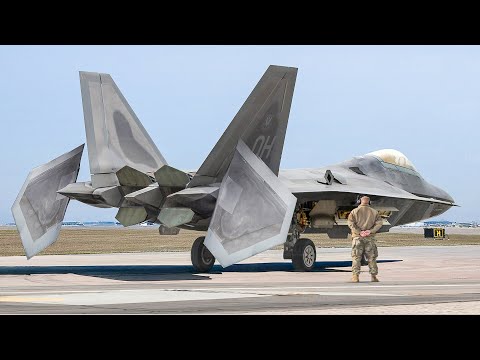
Introduction
The F‑22 Raptor is a twin-engine, all-weather stealth fighter developed by Lockheed Martin and Boeing under the Advanced Tactical Fighter program.
It first flew in 1997 and was officially introduced into service in December 2005.
Though its primary mission is air dominance, the F‑22 also has ground-attack, electronic warfare, and intelligence roles baked into its design.
Design & Features
Stealth / Low Observability
One of the defining features of the F‑22 is its stealth design. The airframe shape, radar-absorbent materials, and special coatings reduce its detectability to enemy radar systems.
Its surface coatings are more than just paint—they consist of multiple layers engineered to absorb or scatter radar energy.
Supercruise & Performance
The F‑22 can sustain supersonic flight (about Mach 1.5 to Mach 1.8) without needing afterburners—a capability known as supercruise.
When afterburners are used, it can exceed Mach 2.
Its advanced thrust vectoring and high thrust-to-weight ratio give it excellent maneuverability, allowing it to out-turn or out-maneuver many contemporaries.
Sensors, Avionics & Situational Awareness
A key strength of the F‑22 is sensor fusion: it integrates data from its radar, infrared, electronic warfare systems, communications, and other sensors to give the pilot a rich, synthesized battlefield picture.
Its AESA radar, advanced electronic warfare suite, and data link capabilities help it detect, track, jam, or engage threats and also coordinate with other aircraft.
Armament & Payload
In air-to-air configuration, the F‑22 typically carries six AIM-120 AMRAAM missiles and two AIM-9 Sidewinder missiles in internal bays, to preserve stealth.
For ground attack, it can carry two 1,000-pound JDAMs internally and additional weapons in future upgrades.
It also has an internal M61A2 20 mm cannon.
Airframe & Materials
The F‑22 uses advanced composite materials and manufacturing techniques. One example: large structural parts are made using Resin Transfer Molding (RTM) to improve consistency and reduce weight.
Its design balances stealth, aerodynamic performance, strength, and weight.
Operational History & Deployment
The F‑22 has been used in real-world operations, including striking ground targets in the campaign against ISIS (Operation Inherent Resolve) beginning in 2014.
It achieved its first air-to-air “kill” by downing a Chinese surveillance balloon in 2023.
Deployments include forward operations in the Indo-Pacific, deterrence missions over NATO’s eastern flank, and rapid repositioning to support U.S. Central Command operations. It also frequently participates in exercises and patrols to assert U.S. air dominance and reassure allies.
Challenges, Upgrades & Future
Maintenance & Readiness
In recent years, readiness rates have fluctuated, and the USAF has considered retiring older, non-modernized F‑22s to allocate resources to future systems.
Modernization
Efforts are underway to upgrade avionics, sensors, and sustainment systems to keep the F‑22 relevant until it can be succeeded (likely by the Next‑Generation Air Dominance / “F‑47” program).
Lockheed Martin emphasizes open systems architecture to facilitate future upgrades.
Competition & Replacement
Though the F‑22 remains highly capable, its high cost, complex maintenance, and evolving threat environment push the development of next-generation fighters.
The F‑22 is expected to continue in front-line roles into the 2030s, bridging toward newer platforms.
Conclusion
The F‑22 Raptor remains one of the most advanced fighter aircraft ever built. Its unmatched combination of stealth, speed, avionics, and lethality gives it a central role in U.S. air dominance strategy. While costs and aging systems present challenges, ongoing upgrades and careful management aim to keep it relevant until its eventual successor arrives.

You must be logged in to post a comment.